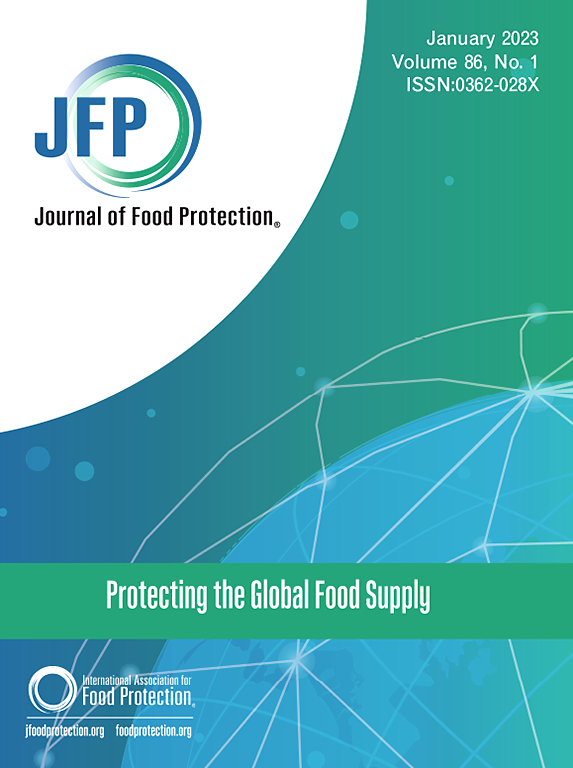Temporality and Genetic Relatedness of Salmonella in a Pork Processing Facility
IF 2.1
4区 农林科学
Q3 BIOTECHNOLOGY & APPLIED MICROBIOLOGY
引用次数: 0
Abstract
The goal of this study was to investigate the prevalence and genetic relatedness of Salmonella enterica in meat and contact surfaces from two processing lines at a pork processing plant over a commercial production schedule. Across 192 samples, there was no significant difference in Salmonella prevalence between Bootjack Trim (BJ) and Boston Butt Trim (BBT) meat (11.5% vs. 11.5%, P = 1.0), though prevalence was higher in meat than on contact surfaces for both the BJ (11.5% vs. 0%, P = 0.01) and BBT (11.5% vs. 3.1%, P = 0.08) processing lines. Both Salmonella prevalence and identified serotypes clustered within four distinct processing windows that spanned multiple dates and processing lines. Phylogenetic analysis using core single nucleotide polymorphisms (SNPs) identified a highly related Salmonella I4,[5],12:i:- strain (N = 33, 0–2 SNPs difference across all isolates) in both the BJ and BBT lines, persisting over consecutive days within one processing window. Similarly, a highly related Salmonella London strain (N = 18, 0–1 SNPs) was found across both processing lines on three processing dates that spanned 28 days. Additional highly related strains of Salmonella Typhimurium (N = 8, 0–1 SNPs) and Salmonella Agona (N = 7, 0–3 SNPs) were also detected across multiple dates. Strains of S. I4,[5],12:i:- and S. London were genetically distinct (>30 SNPs) from publicly available genomes from isolates obtained from other pork processing plants located in the Upper Midwest. Overall, findings suggested that Salmonella prevalence varies across processing lines and production schedules. However, the high phylogenetic relatedness among the Salmonella serotypes suggests a common source may have been present prior to each primal cut being processed into subprimal cuts.
猪肉加工设施中沙门氏菌的时效性和遗传相关性。
本研究的目的是调查一家猪肉加工厂两条加工线的肉类和接触表面中肠沙门氏菌的流行率和遗传相关性。在192个样品中,Bootjack Trim (BJ)和Boston Butt Trim (BBT)肉的沙门氏菌患病率无显著差异(11.5%比11.5%,P = 1.0),尽管BJ(11.5%比0%,P = 0.01)和BBT(11.5%比3.1%,P = 0.08)加工线的肉类患病率高于接触面。沙门氏菌流行率和已确定的血清型均聚集在跨越多个日期和加工线的四个不同加工窗口内。利用核心单核苷酸多态性(SNPs)进行系统发育分析,在BJ和BBT品系中发现了高度相关的沙门氏菌I4,[5],12:i:-菌株(N = 33,0 - 2个SNPs差异),在一个加工窗口内连续持续数天。同样,在28天的三个加工日期中,在两条加工线上发现了高度相关的伦敦沙门氏菌菌株(N = 18,0 - 1 snp)。鼠伤寒沙门菌(N = 8,0 - 1个snp)和阿戈纳沙门菌(N = 7,0 - 3个snp)也在多个日期检测到高度相关的菌株。S. I4、[5]、12:i:-和S. London菌株与从中西部上游其他猪肉加工厂获得的公开基因组分离物具有遗传差异(>30个snp)。总体而言,研究结果表明,沙门氏菌的流行率在不同的加工生产线和生产计划中有所不同。然而,沙门氏菌血清型之间的高度系统发育相关性表明,在每个原始伤口被加工成次原始伤口之前,可能存在一个共同的来源。
本文章由计算机程序翻译,如有差异,请以英文原文为准。
求助全文
约1分钟内获得全文
求助全文
来源期刊

Journal of food protection
工程技术-生物工程与应用微生物
CiteScore
4.20
自引率
5.00%
发文量
296
审稿时长
2.5 months
期刊介绍:
The Journal of Food Protection® (JFP) is an international, monthly scientific journal in the English language published by the International Association for Food Protection (IAFP). JFP publishes research and review articles on all aspects of food protection and safety. Major emphases of JFP are placed on studies dealing with:
Tracking, detecting (including traditional, molecular, and real-time), inactivating, and controlling food-related hazards, including microorganisms (including antibiotic resistance), microbial (mycotoxins, seafood toxins) and non-microbial toxins (heavy metals, pesticides, veterinary drug residues, migrants from food packaging, and processing contaminants), allergens and pests (insects, rodents) in human food, pet food and animal feed throughout the food chain;
Microbiological food quality and traditional/novel methods to assay microbiological food quality;
Prevention of food-related hazards and food spoilage through food preservatives and thermal/non-thermal processes, including process validation;
Food fermentations and food-related probiotics;
Safe food handling practices during pre-harvest, harvest, post-harvest, distribution and consumption, including food safety education for retailers, foodservice, and consumers;
Risk assessments for food-related hazards;
Economic impact of food-related hazards, foodborne illness, food loss, food spoilage, and adulterated foods;
Food fraud, food authentication, food defense, and foodborne disease outbreak investigations.
 求助内容:
求助内容: 应助结果提醒方式:
应助结果提醒方式:


